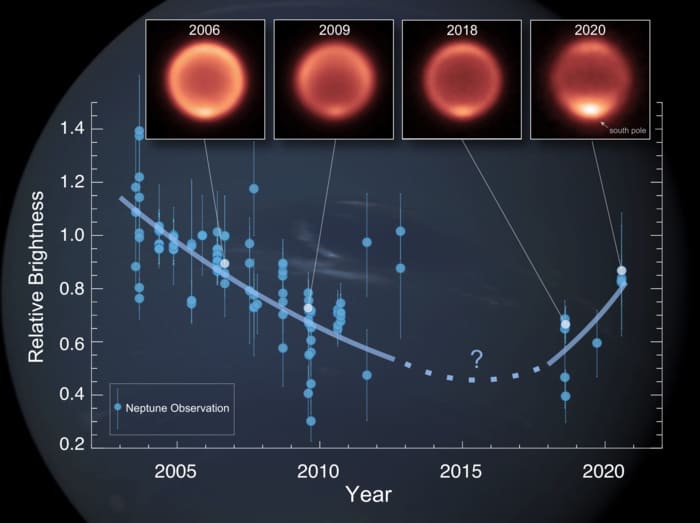
The atmosphere of the planet Neptune has undergone significant and “frankly unexpected” changes to its atmospheric temperature over the past two decades, say scientists at the University of Leicester, UK. The team drew this conclusion by analysing images from multiple observatories, including the European Southern Observatory’s Very Large Telescope, Gemini Southern Observatory in Chile and the Subaru, Gemini North, and Keck Observatories in Hawaii.
“Temperatures in Neptune’s stratosphere (the relatively stable region of the atmosphere above the ‘weather layer’) have dropped significantly over the last 20 years,” says Michael Roman, a postdoc at Leicester who led the research. “This is contrary to theoretical expectations.”
Seasons out of kilter
Because Neptune’s axis is tilted by 28°, it experiences seasons similar to those on Earth, which has an axial tilt of 23.5°. The difference is that because Neptune is so far from the Sun, it takes nearly 165 years to complete an orbit – meaning that each season lasts nearly 41 Earth-years.
At the moment, it is early summer on the side of Neptune that faces Earth, so the researchers expected the temperature to be increasing slowly over the planet’s entire southern hemisphere. To their surprise, they observed the opposite: global average stratospheric temperatures in fact decreased by roughly 8°C between 2003 and 2018. A further surprise came from a subsequent dramatic change in temperatures at Neptune’s south pole, which warmed by 11˚C between 2018 and 2020.
This result suggests that seasonal response and temperature variability on Neptune is more complicated than we previously thought, Roman tells Physics World. “It forces us to revise our theories and models of this ice giant’s atmosphere and tests our understanding of how planetary atmospheres vary over time and respond to different conditions. These include extremely long seasons, variation in the solar cycle, and even possible changes in Neptune’s meteorology.”

Things we don’t know about Uranus (and Neptune)
The Leicester researchers obtained their results using thermal-infrared images of Neptune taken with sensitive instruments on 8-metre class telescopes in Chile and Hawaii. “We gathered all the thermal-infrared data that currently exists for our analysis to better sample the atmospheric temperatures over time,” says Roman. “This amounted to multiple spectra and over 95 images spanning 17 years (2003-2020).”
A clearer and fuller picture
By combining these different images and analysing all the data collectively, the researchers say they uncovered a clearer and fuller picture of Neptune’s changing temperatures than ever before. After detailing their work in The Planetary Science Journal, they are now revising their theories and models of Neptune’s atmosphere.
“We can only speculate what has caused the temperature changes we have documented, but more observations will be necessary to test our theories,” Roman says. He adds that NASA’s James Webb Space Telescope, which launched on 25 December 2021 and is currently being commissioned, should provide “key measurements” of Neptune’s temperature and chemistry beginning in 2023. “But to really understand the nature of the observed temporal variability, it is also very important that we continue to observe Neptune frequently over the next decade using the world’s great observatories in Chile and Hawaii,” he concludes.
